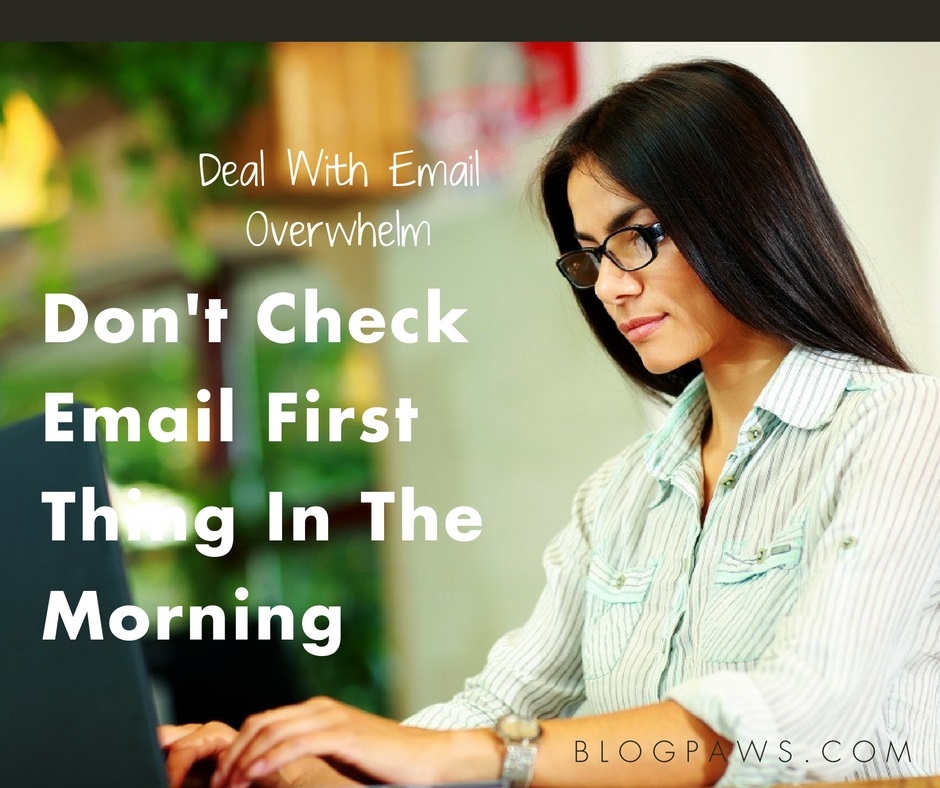Freelancing 101: Productive Ways To Manage Your Inbox
Show of hands: How many of you have a clean, organized and in-control email inbox? Chances are, many of you are looking at your inbox and wondering:
- How it got so out of control
- How to get it back in control
- How to manage it going forward
Read on for tips and tricks that will help you gain control of the inbox without having to delete every message and start from scratch (I know people who have done that, and it just didn’t work). Yvonne had written a post about email etiquette and managing your inbox is another way to practice email etiquette. How? Imagine a potential business partner or a brand reaches out to you with an opportunity and you don’t respond because you can’t find or didn’t even see the message? You’ve lost an opportunity and have potentially burned a bridge because you will be deemed unprofessional. No pet blogger wants that.
Let’s get one thing straight: You are an entrepreneur. You have a LOT to do and not all of that includes responding to the myriad email messages you receive every day, right? If you’re focusing on email, then your client tasks simply won’t get done. Let’s face it though: If you have an email address, chances are you have an overflowing inbox. It seems it’s a fact of doing business in our electronic era.
If your stomach clenches when you hear your phone chime that you have new emails. If you dread opening your email because you just know there will be tens, if not hundreds, of messages. Not all of them will require your attention, but I’ll bet way more than half of them will.
Consider these sources of email overload:
- Spam
- Newsletters
- Memes from friends
- Messages from friends and family that are non-work related
- Social media notifications
- Requests for proposals
- Comments to respond to from blog posts you’ve written
- Responses to messages you’ve sent… and on and on
I’ve found, when working with my clients, that they wake up with good intentions, “I’m going to check my email, respond to EVERYTHING, and then I’ll be able to get to the rest of my day, email-worry-free.” Doesn’t happen though, does it? Of course not. You may answer your messages in the morning, but I’ll bet that by noon (or even 10 am) your inbox is already starting its capacity creep.
An inbox that is filled with hundreds or thousands of unread messages is disheartening. The feeling of overwhelm that it brings can be self-defeating to your, “get ‘er done” attitude. You may just throw up your hands and say, “The only way to get rid of email overload is to go off the grid!”
Slow down. Take a deep breath… and read on. What you truly need is an email management and productivity plan. Sounds sweet, right? It is! First things first, let’s do a week of email auditing. Keep track of emails you receive and I imagine you’ll find that many of them fall into the same, or similar categories. Those categories include:
- Personal messages
- Spam
- Customer messages
- Social media messages and alerts
- Critical to-do items
- Old messages (some people find it helpful to say, “As of August 18 I am starting from scratch with my inbox,” and they will put ALL old messages into a folder so the inbox is starting from zero. Those messages put into the Old Message folder will need to be addressed, but in increments)
After your email audit week set up folders for your messages. WORD OF CAUTION: Just because you’re setting up folders doesn’t mean you simply get to drag the message into that folder and “get to it later.” Part of email management is dealing with a message as soon as you touch it. Even if it’s something you don’t want to deal with now, you have to train yourself to just touch it and take care of it. Then you can let it go.
Back to folders: Set up folders that encompass the (stick to no more than five) types of email you receive. Spam doesn’t need to be kept, it should simply be deleted or your spam filter should be set high enough that these messages don’t hit your inbox. Do give spam messages a quick scan as I have found emails that I need that have been marked spam due to the vagaries of the email algorithms.
Now that you’ve set up your folders, I urge you:
 Don’t check your email first thing in the morning.
Don’t check your email first thing in the morning.
When you do this you’re putting out other people’s fires. Checking email first thing in the morning puts you into reactive mode and it also drains your energy. Save your morning for your most pressing or brain-intensive tasks–email is not that task.
Productively deal with email by:
- Setting up several times per day when you will check messages (for example, 10 am, 2 pm and 5 pm). Turn off email alerts. If you’re worried your friends, family and clients will freak out because they are waiting three or four hours to hear back from you, set up an auto-responder email. “Hey! Thanks for your message. Please be advised that I check my email at 10 am, 2 pm and 5 pm. If you’ve written between those times, know that I will get back to you at those allotted times. If it’s an emergency, please text me.” I’ve done that and since I started it a year and a half ago I have received two text messages. Hmm, see not many of those emails were emergencies.
- When you check your email at those allotted times, you must act on them. No “setting them aside until later.” If you do that, then at the next allotted time you will be faced with an even bigger stack of messages. Touch it. Work on it. Move on. Don’t spend hours on the inbox at the allotted time, either. Decide that you will spend one hour and get through what you can. Sure you may not get through the entire inbox, but you will be making slow, but steady progress.
- Know that it didn’t take you a day to get this overwhelmed with email, and it will take you more than a day or a week to get out of the email overwhelm. Set aside time throughout the week – perhaps 30 minutes a day – go to the beginning of your email and begin working through it. If it’s months old, you may be able to just delete it. If you have scads of unread newsletters, decide whether you need to keep them at all. If you’re not reading them, why are you subscribing? If you find a message from months ago that you didn’t respond to, do so now and apologize, “Hey, I see you wrote to me months ago and I am so sorry I never responded. Honestly you got lost in my inbox (you may not want to be so honest…) but I wanted to reach out to you now and see if I can offer my help/respond to your request/work together moving forward… (whatever the case is).” It may be embarrassing, but guess what? You’re not alone in this email inbox overwhelm.
It will take discipline and planning to get the inbox under control and to remain in control moving forward. Believe me, an organized inbox will help your productivity because you won’t be so distracted by the pinging of a new message hitting the inbox and by not feeling you have to respond to an email the second it comes into your inbox.
What are your email inbox pain points? What have you tried, if anything, to regain control of your inbox? Let us know in the comments.
Robbi Hess is an award-winning author, full-time writer, newspaper columnist, writing coach and time-management guru. She works with bloggers and solopreneurs and blogs at All Words Matter.
Images: Dean Drobot/Shutterstock.com and Dasha Petrenko/Shutterstock.com







